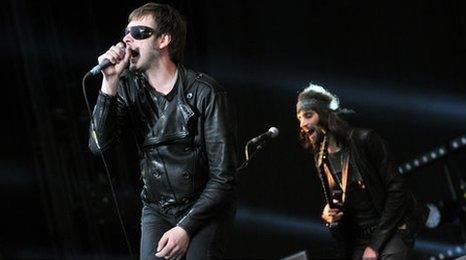Think Pink: A clickable guide to Kasabian's album
- Published
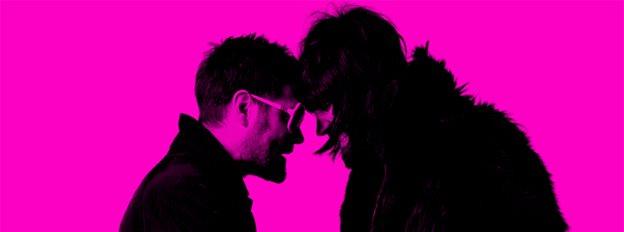
Kasabian's Tom Meighan (left) and Serge Pizzorno have scored hits including LSF, Empire and Fire
Kasabian's Serge Pizzorno provides an annotated guide to the band's new album, and says he can't wait to prove their critics wrong at Glastonbury.
He's the driving force behind Britain's loudest, maddest rock band - but, in person, Serge Pizzorno is surprisingly serene. Sipping tea from a Kit Kat mug, the guitarist is quietly, if passionately, spoken as he discusses Kasabian's fifth album, 48:13.
"I'm so relieved," he says. "It took me a year. You go through the process of asking, 'Is that chorus big enough? Is that section too fast?'
"So what's amazing is seeing this," he says, indicating a glossy A1 sheet containing proofs for the CD's artwork. "That means it's finished, so I can't do anything else. It's never going to be perfect. I just know that I'm ready to give it away now."
As we discuss the record, Pizzorno grabs a pen and scribbles notes on the fold-out pink booklet - underlining lyrics and circling names in the credits to emphasise his points.
-
Kasabian CD artwork
× [an error occurred while processing this directive]
[an error occurred while processing this directive] -
Pink = punk
×The perception of our band is that we’re really masculine, so people won’t be expecting a pink cover. Pink is the ultimate way of saying “I don’t care what you think” - there’s a very punk element to it.
-
Mosh pit from space
×Bumblebeee was the first tune we made for the record. I wanted to talk directly to the fans in the front row, especially the people in the mosh pit, and the night you have together. When they hit it as hard as you do, there’s an incredible rush. It feels like Ecstasy, man, it feels incredible.
-
'Infinite distraction machine'
×This is a song called Glass. I went in a train carriage and I looked from one end to the other, and everyone was on their phone or looking at glass screens. I understand it. I’ve done it myself. But people used to look out the window and imagine. Boredom is such an important energy. That’s when you think of new things, that’s when you start creating. When did it happen that we stopped caring about what’s going on around us? We’re happy to get lost inside an infinite distraction machine.
-
Leicester
×There’s a moment in Treat where the track drops out just as we say Leicester which is, like, a proper move. Leicester is so important to us. We all still live there. We’re playing a show in the centre of the town to celebrate 10 years of the band. That’s going to be our moment, I think.
-
Grandad
×That’s my grandad, Wilf Dillon, in the credits. He’s on a track called (mortis) – and he just says “in mortis ora incerta est”, which is “the hour of death is uncertain”. There’s something powerful about a 94-year-old man saying that.
-
Complete madness!!!
×The whole vision from the start of the record was to keep everything direct. One-word titles, all the music, the lyrics - everything was direct. We were like, “you know, we should call it something like 48:13”. I got attached to those numbers. It’s so silly. But for me something about that felt right. And when we put all the tracks in order – Bang! No word of a lie, where it stopped was 48:13.
-
Skeletons
×The skeleton thing we started doing towards the end of the Velociraptor record. We’d been on tour so long, and you get so bored, so we were, “right, we need to do something”. So we bought loads of skeleton outfits and after gigs we’d put them on and go into towns and parties and bars. We found this weird park with a bouncy castle. We went to LA and walked through the hotel lobby – about 15 of us – and jumped into the pool. So Tom’s gloves are a little nod to that. The skeletons will appear at Glastonbury, I think.
-
Sambuca
×I forgot I did that photo without a top on. I think there might have been a lot of Sambuca involved in that decision.
-
Direct!!
×The songs all have one-word titles… The music is like, BANG, so I wanted everything to be that direct. Some songs originally had other names but it just looks such a mess. So Live to Fight Another Day became Stevie. Everything had to be in your face.
"The whole vision from the start of the record was to keep everything direct," he says. "One-word titles, all the music, the lyrics, everything was direct."
In that spirit, the album is called 48:13, which is precisely how long it lasts.
"I wasn't trying to be clever," Pizzorno says. "The album is the sum of all its parts - and that's 48 minutes and 13 seconds."
Bizarrely, he decided on the title before the album was recorded, having become "attached" to the numbers. "It's so silly," he says, "but for me something about that felt right."
Having to stick to the arbitrary running time helped focus his writing, he says.
"It's weird, because essentially it goes against creativity, but sometimes the idea of being able to do anything hurts your head. Then, if you say, 'Right, this album's not going to have this sort of sound, or this sort of song on it,' then you've got a start.
"Setting yourself restrictions, you can go as mad as you want, as long as it's within the structure."
48:13 is the first Kasabian album Pizzorno has produced on his own. Working in his small studio - "essentially it's just a synthesizer museum" - he was free to indulge his most outlandish ideas.
Kasabian's belligerent, anthemic choruses are still present, but this time they're interspersed with Eastern interludes, Chicago house beats and sudden, unexpected switches.
"In some ways, I've been training 10 years to make this record," he says. "This is the definitive Kasabian record... to date."
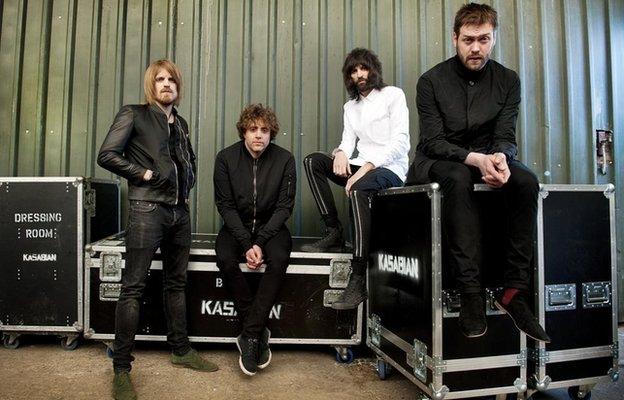
That dressing room looks small. Kasabian (L-R): Chris Edwards, Ian Matthews, Serge Pizzorno, Tom Meighan
As he pieced the record together, Pizzorno was inspired by "the drop" - the climactic build and release of tension employed by dance music. But it was Kanye West's stripped-down and abrasive Yeezus album that really spurred him to action.
"How can you listen to that and not go, 'I need to get in the studio right now?'" he says.
West's album prompted Pizzorno, whose "first instrument was a sampler", to really push the band's hip-hop inclinations.
"They were always there, but now they're leading the charge." To the extent that 48:13 barely resembles a rock album at all.
"God knows what it is," says Pizzorno. "There's guitars on it - but I don't think it's rock. It feels new, that's what it feels like."
The centrepiece is Treat, a seven-minute track that begins as a rambunctious tale of a night out in Leicester ("I'm stood here naked with a junkie sinking Margaritas") before unexpectedly blossoming into an extended, percolating synth groove.
"I felt that song had a really futuristic sound, like future rock," says Pizzorno. "In my head, I was like, 'How do you end a song like that?' And obviously, psychedelic music has been a huge part of my life. And with modern psychedelia, what do you do? You go off into space. That's how you end that song."
Treat has already been successfully road-tested live, much to Pizzorno's delight. "It was a minute into the second part and, all of a sudden, this chaotic gig mosh mentalness just stopped and everyone was just dancing. It was so amazing."
But the track poses a problem for singer Tom Meighan. What on earth does he do during the four-minute instrumental? "Depending on his mood, I think he'll stay on stage and dance," Pizzorno laughs. "But some nights, I just think he'll go off and have a little drink at the back."
In a couple of weeks, "at the back" will be a huge field in Somerset - where the band are, somewhat controversially, headlining Glastonbury.
Their addition to the line-up was received almost as badly as Jay-Z's booking in 2008. Elements of the music press, which still portray Kasabian as beer-throwing "lad rock" Neanderthals, were particularly unimpressed. And Pizzorno can't wait to prove them wrong.
"When we step out on that stage, with all we know and everything we've learned, we have an advantage," he says of the band's blistering live show. "If you're not expecting much, wait until you see what's about to happen to you."
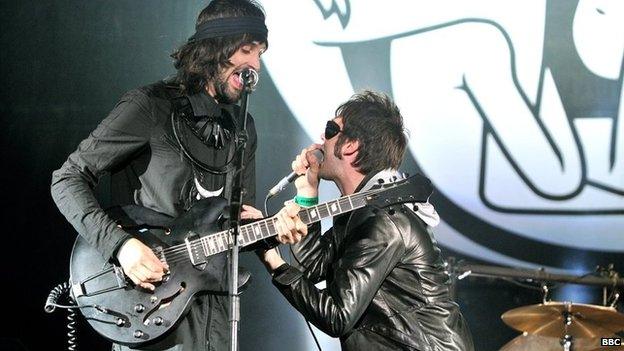
The band previously headlined Reading and Leeds in 2012, unexpectedly playing a cover of The Korgis' Everybody's Got To Learn Sometime
The guitarist sees Glastonbury as "validation" from the industry, but he's even more fired up about another upcoming show.
On 21 June, the band will play to 35,000 people in Victoria Park, mere steps away from where they grew up in Leicester.
"The reason we chose that location is that it's the centre of the town," Pizzorno says. "It's not on the outskirts in a farm, or anything. The train station is two minutes walk, and it sits on the top of a hill where you can pretty much see all of Leicester. It's an unbelievable venue."
The band are excited at the prospect of inspiring a new generation of Leicester musicians, particularly because there were no local role models when they were teenagers.
"The audience will see people from just down the road who created all this from nothing," Pizzorno says. "That's why that gig is so important, for our city to realise that anything is possible.
"It's perfect timing," he adds. "To go on stage and celebrate 10 years of our band, with our best record yet, is great.
"That's going to be our moment, I think."
Kasabian's album, 48:13 is out now. They play Victoria Park on 21 June, and close the Glastonbury Festival the following week.
- Published4 April 2014
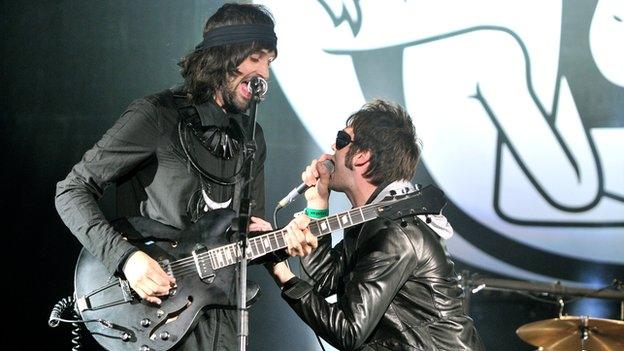
- Published8 May 2014
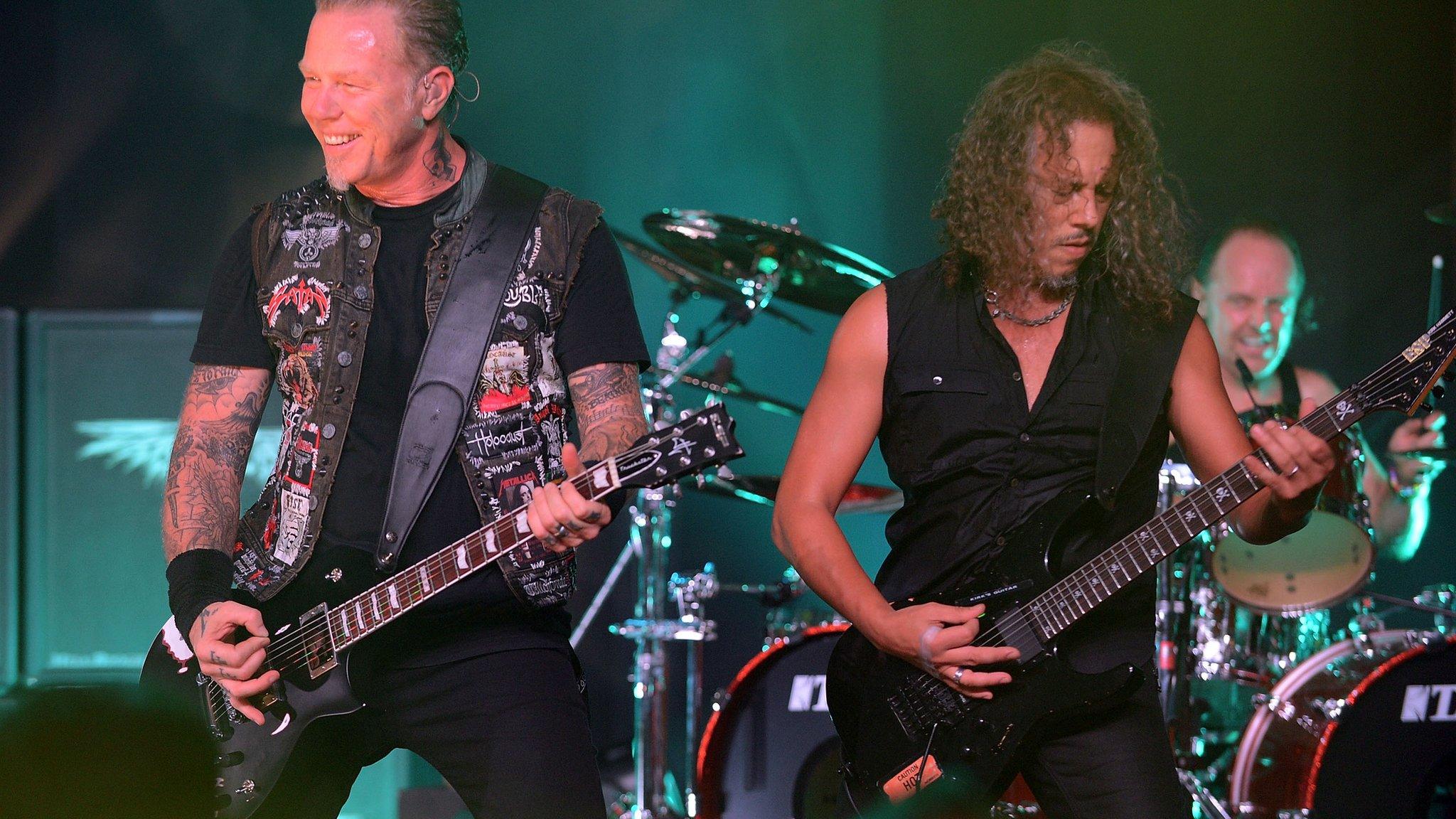
- Published6 March 2013
